Cold fermentation enhances pretzel flavor by allowing the dough to develop complex, tangy notes and a chewier texture through slow yeast activity. Same-day rise produces a milder, sweeter taste with a softer crumb, as the yeast ferments quickly at warmer temperatures. Choosing cold fermentation results in richer taste depth and improved crust characteristic of traditional pretzels.
Table of Comparison
| Factor | Cold Fermentation | Same-Day Rise |
|---|---|---|
| Fermentation Time | 12-48 hours in refrigerator | 1-3 hours at room temperature |
| Flavor Development | Rich, complex, tangy | Mild, less developed |
| Texture | Chewy, well-structured crumb | Soft, less chewy |
| Ease of Preparation | Requires planning, longer wait | Quick, suitable for same-day baking |
| Yeast Activity | Slower, controlled fermentation | Faster, aggressive rise |
| Optimal Use | Artisan pretzels with depth of flavor | Quick pretzels, less complexity |
Key Differences Between Cold Fermentation and Same-Day Rise
Cold fermentation enhances pretzel flavor by allowing yeast to slowly develop complex aromas and a chewier texture over several hours or days, while same-day rise results in a lighter, less intense taste due to rapid fermentation. The extended fermentation in cold conditions increases enzymatic activity, producing deeper Maillard reactions during baking that contribute to the pretzel's characteristic brown crust and rich, nutty notes. In contrast, same-day rise prioritizes speed and efficiency, yielding a softer crust and milder flavor profile favored for quick service or batches requiring immediate consumption.
How Fermentation Time Impacts Pretzel Flavor
Extended cold fermentation enhances pretzel flavor by allowing natural enzymes to break down starches into sugars, producing a richer, more complex taste and a deeper color during baking. Same-day rise results in a milder, less developed flavor due to shorter fermentation, limiting yeast activity and byproduct formation. Longer fermentation also improves dough texture, contributing to the characteristic chewy interior and crisp crust essential to authentic pretzels.
Science Behind Cold Fermentation in Pretzel Dough
Cold fermentation enhances pretzel flavor by allowing yeast to slowly metabolize sugars, producing more complex organic acids and alcohols that deepen taste and aroma. The extended fermentation time at low temperatures promotes the development of lactic acid bacteria, which contribute to a subtle tang and improved dough texture. In contrast, same-day rise results in a simpler flavor profile due to rapid yeast activity and limited acid formation.
Same-Day Rise: Fast Results, Flavor Trade-Offs
Same-day rise pretzels offer a rapid production cycle by fermenting dough for only a few hours, accelerating bakery output but often sacrificing depth of flavor and texture complexity compared to cold fermentation. The shorter fermentation limits enzymatic activity, resulting in less developed malt and caramel notes that define traditional pretzel flavor profiles. Bakers prioritizing speed must balance these trade-offs, employing techniques like dough conditioners or enhanced baking methods to compensate for the reduced fermentation time.
Flavor Complexity: Cold Fermentation vs Same-Day Methods
Cold fermentation enhances pretzel flavor complexity by allowing slow yeast activity, which produces deeper, tangier notes and a chewier texture. Same-day rise results in a milder flavor profile and softer texture due to rapid yeast fermentation. For artisanal pretzels, cold fermentation is preferred to develop nuanced, robust flavors favored by connoisseurs.
Texture and Appearance: Effects of Rising Techniques
Cold fermentation enhances pretzel texture by allowing slow yeast activity, resulting in a chewier crumb and deeper color due to extended enzymatic reactions. Same-day rise produces a softer, fluffier interior with a lighter crust, offering a milder flavor profile and less pronounced browning. The choice of rising technique directly influences pretzel appearance, with cold fermentation yielding a darker, more evenly golden crust and same-day rise creating a paler, less caramelized exterior.
Choosing the Right Method for Authentic Pretzel Taste
Cold fermentation enhances pretzel flavor by allowing yeast to slowly develop complex, tangy notes over 12 to 48 hours, producing a chewier texture and deeper crust browning. Same-day rise accelerates the process but often yields a milder taste and softer crumb, ideal for quick preparation without sacrificing basic pretzel integrity. Opting for cold fermentation is key to achieving an authentic pretzel profile characterized by rich aroma and traditional bite.
Best Practices for Cold Fermented Pretzels at Home
Cold fermentation enhances pretzel flavor by allowing the dough to develop complex, tangy notes through slow yeast activity over 12 to 48 hours in the refrigerator. Best practices include tightly covering the dough to prevent drying, maintaining a consistent low temperature around 38degF, and allowing the dough to rest at room temperature briefly before shaping for optimal elasticity. This method produces chewier texture and richer flavor compared to same-day rise, which often yields a mild taste and denser crumb.
Time Management: Scheduling Your Pretzel Bake
Cold fermentation enhances pretzel flavor by allowing the dough to develop complex, tangy notes during a slow, overnight rise, making it ideal for bakers scheduling ahead. Same-day rise accelerates the fermentation process, producing a milder flavor suitable for quick pretzel preparation and tight baking schedules. Efficient time management balances flavor development with bakery workflow, optimizing production without compromising pretzel quality.
Pretzel Recipes: Cold Fermentation and Same-Day Comparisons
Cold fermentation enhances pretzel flavor by allowing the dough to develop complex, tangy notes through slow enzymatic activity over 12-48 hours, resulting in a chewier texture and richer crust. Same-day rise methods produce a milder taste with a softer crumb due to rapid yeast fermentation, offering convenience but less depth in flavor. Recipes utilizing cold fermentation often require longer proofing times and refrigeration, creating a preferred balance between dough elasticity and enhanced Maillard reaction for browning during baking.
Cold fermentation vs same-day rise for pretzel flavor Infographic

 cookingyes.com
cookingyes.com